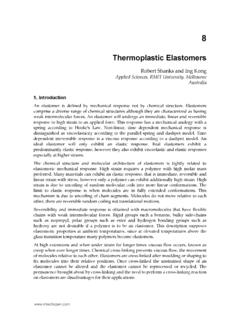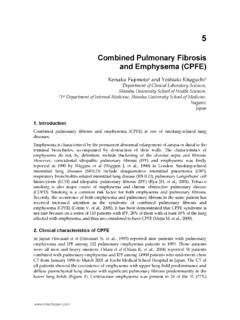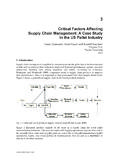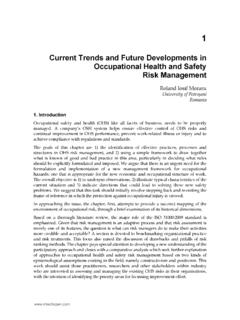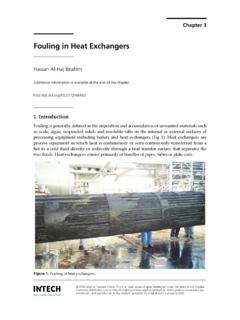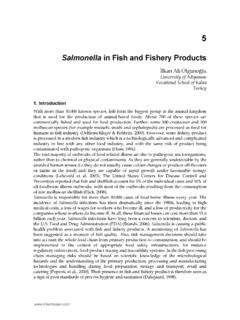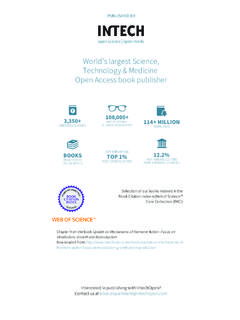Transcription of Genotoxic Impurities in Pharmaceuticals - InTech - Open
1 17. Genotoxic Impurities in Pharmaceuticals Abolghasem Jouyban1 and Hamed Parsa2. 1 Drug Applied Research Center and Faculty of Pharmacy, 2 Tuberculosis and Lung Disease Research Center, Tabriz University of Medical Sciences, Tabriz, Iran 1. Introduction Genotoxic compounds induce genetic mutations and/or chromosomal rearrangements and can therefore act as carcinogenic compounds (McGovern and Jacobson-Kram, 2006). These compounds cause damage to DNA by different mechanisms such as alkylation or other interactions that can lead to mutation of the genetic codes. In general, chemists employ the terms " Genotoxic " and "mutagenic" synonymously; however, there is a subtle distinction. Genotoxicity pertains to all types of DNA damage (including mutagenicity), whereas mutagenicity pertains specifically to mutation induction at the gene and chromosome levels.
2 Thus, the term Genotoxic is applied to agents that interact with DNA and/or its associated cellular components ( the spindle apparatus) or enzymes ( topoisomerases) (Dearfield et al., 2002; Robinson, 2010). Irrespective of the mechanism by which cancer is induced, it is now well agreed that it involves a change in the integrity or expression of genomic DNA. The majority of chemical carcinogens are capable of causing DNA damage, , are " Genotoxic " (Ashby, 1990). Moreover, a Genotoxic compound also carries with it the carcinogenic effect which causes additional concern from the safety viewpoint. Drug substances and their relative compounds such as Impurities constitute an important group of Genotoxic compounds. Thus, these compounds pose an additive concern to clinical subjects and patients (M ller et al., 2006). Considering the importance of this problem, the challenge for regulatory agencies is to form guidelines and standards for the identification and control of Genotoxic compounds and their Impurities especially in Pharmaceuticals .
3 In this article, genotoxicity profiles of the main group of Genotoxic compounds are discussed. The article throws light on the challenges in analyzing and predicting for these groups and also deals with the different management problems of Genotoxic Impurities in Pharmaceuticals . 2. Guidelines ICH guidelines The International Conference on Harmonization (ICH) of Technical Requirements for Registration of Pharmaceuticals for Human Use project represents the main group of guidelines with topics such as "Quality" topics and "Safety" topics. Quality topics relate to chemical and pharmaceutical quality assurance (stability testing, impurity testing, etc.) and 388 Toxicity and Drug Testing safety topics deal with in vitro and in vivo pre-clinical studies (carcinogenicity testing, genotoxicity testing, etc.) (ICH, 2008). The ICH initially published guidelines on Impurities of drug substances and pharmaceutical products in the late 1990s.
4 In the guidelines, genotoxicity tests have been defined as in vitro and in vivo tests designed for detecting compounds that induce genetic damage directly or indirectly (International Conference on Harmonization, 1997). The ICH quality guidelines Q3A(R) and Q3B(R) respectively address the topics of control of Impurities in drug substances and degradants in pharmaceutical products, while the Q3C guideline deals with the residual solvents. However, several important issues have not been addressed in the guidelines, for example, the acceptable levels of Impurities in drugs during development as well as the control of Genotoxic Impurities . Table 1 illustrates a series of thresholds described in ICH Q3A(R) that trigger reporting, identification, and qualification requirements. Subsequently, Table 2 depicts the thresholds for reporting, identification, and qualification of Impurities in new drug products (ICH, 2006; Jacobson-Kram and McGovern, 2007).
5 In addition, two options for standard test battery for genotoxicity are available in the ICH S2. (R1) guideline (ICH, 2008): Maximum daily dose Thresholds 2 g/day >2 g/day Reporting threshold or mg per day intake Identification threshold (whichever is lower). or mg per day intake Qualification threshold (whichever is lower). Table 1. Threshold for APIs Option 1. i. A test for gene mutation in bacteria;. ii. A cytogenetic test for chromosomal damage (the in vitro metaphase chromosome aberration test or in vitro micronucleus test), or an in vitro mouse lymphoma tk gene mutation assay;. iii. An in vivo test for genotoxicity, generally a test for chromosomal damage using rodent hematopoietic cells, either for micronuclei or for chromosomal aberrations in metaphase cells. Option 2. i. A test for gene mutation in bacteria;. ii. An in vivo assessment of genotoxicity with two tissues, usually an assay for micronuclei using rodent hematopoietic cells and a second in vivo assay.
6 As stated by the ICH safety guidelines (S2A and S2B), "for compounds giving negative results, the completion of 3-test battery, perform and evaluate in accordance with current recommendations, will usually provide a sufficient level of safety to demonstrate the absence of Genotoxic activity." Thus, any compound that produces a positive result in one or more assays in the standard battery has historically been regarded as Genotoxic , which may require further testing for risk assessment (M ller et al., 2006). Genotoxic Impurities in Pharmaceuticals 389. Maximum Reporting Identification Thresholds2,3 Qualification Thresholds2,3. Daily Dose1 Thresholds2,3. 1 mg or 5 g TDI. whichever is lower 1 10 mg or 20 g TDI. whichever is lower 10 100 mg or 200 g TDI. whichever is lower <10 mg or 50 g TDI. whichever is lower > 10 mg - 2 g or 2 mg TDI. whichever is lower > 100 mg 2 g or 3 mg TDI.
7 Whichever is lower 1 g %. >1g %. >2g >2g 1 The amount of drug substance administered per day 2 Thresholds for degradation products are expressed either as a percentage of the drug substance or as a total daily intake (TDI) of the degradation product. Lower thresholds can be appropriate if the degradation product is unusually toxic. 3 Higher thresholds should be scientifically justified. Table 2. Thresholds for degradation products in new drug products (Jacobson-Kram and McGovern, 2007). EMEA guideline The European Medicines Agency (EMEA) guideline describes a general framework and practical approaches on how to deal with Genotoxic Impurities in new active substances. According to the guideline "The toxicological assessment of Genotoxic Impurities and the determination of acceptable limits for such Impurities in active substances is a difficult issue and not addressed in sufficient detail in the existing ICH Q3X guidance".
8 In addition, the EMEA guideline proposed a toxicological concern (TTC) threshold value of g/day intake of a Genotoxic impurity which is considered to be associated with an acceptable risk (excess cancer risk of <1 in 100,000 over a lifetime) in most Pharmaceuticals . Based on the TTC value, a permitted level of an active substance can be calculated concerning the expected daily dose. Higher limits might be justified under certain conditions such as short-term exposure periods (European Medicines Agency/ Committee for Medicinal Products (CHMP) for Human Use, 2006). In the context of this guideline, the classification of a compound (impurity) as Genotoxic in general indicates that there are positive findings in established in vitro or in vivo genotoxicity tests with the focus on DNA reactive substances that have a potential for direct DNA damage.
9 In the absence of such information, in vitro genotoxics are usually considered as presumptive in vivo mutagens and carcinogens (EMEA/CHMP, 2006). 390 Toxicity and Drug Testing Based on the importance of the mechanism of action and the dose-response relationship in the assessment of Genotoxic compounds, the EMEA guideline presents two classes of Genotoxic compounds: 1. Genotoxic compounds with sufficient (experimental) evidence for a threshold-related mechanism, 2. Genotoxic compounds without sufficient (experimental) evidence for a threshold- related mechanism. Those Genotoxic compounds with sufficient evidence would be regulated according to the procedure as outlined for class 2 solvents in the Q3C Note for Guidance on Impurities : Residual Solvents . For Genotoxic compounds without sufficient evidence for a threshold- related mechanism, the guideline proposes a policy of controlling levels to as low as reasonably practicable (ALARP) principle, where avoiding is not possible.
10 On the other hand, this guideline provides no advice on acceptable TTCs for drugs during development, especially for trials of short duration (Jacobson-Kram and McGovern, 2007). The pharmaceutical research and manufacturing association (PhRMA) has established a procedure for the testing, classification, qualification, toxicological risk assessment, and control of Impurities processing Genotoxic potential in pharmaceutical products. As most medicines are given for a limited period of time, this procedure proposes a staged TTC to adjust the limits for shorter exposure time during clinical trials (Table 3). Thus, the staged TTC can be used for Genotoxic compounds having genotoxicity data that are normally not suitable for a quantitative risk assessment (Muller et al., 2006). Duration of clinical trial exposure 1 > 1-3 > 3-6 >6-12 >12. month month month month month Allowable Daily Intake 120 60 20 10 ( g/day) for all phases of development Alternative maximum level of allowable impurity based on percentage of impurity in API.


